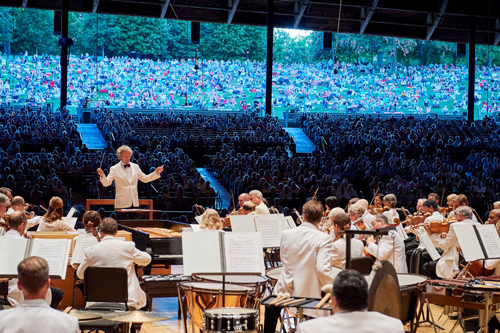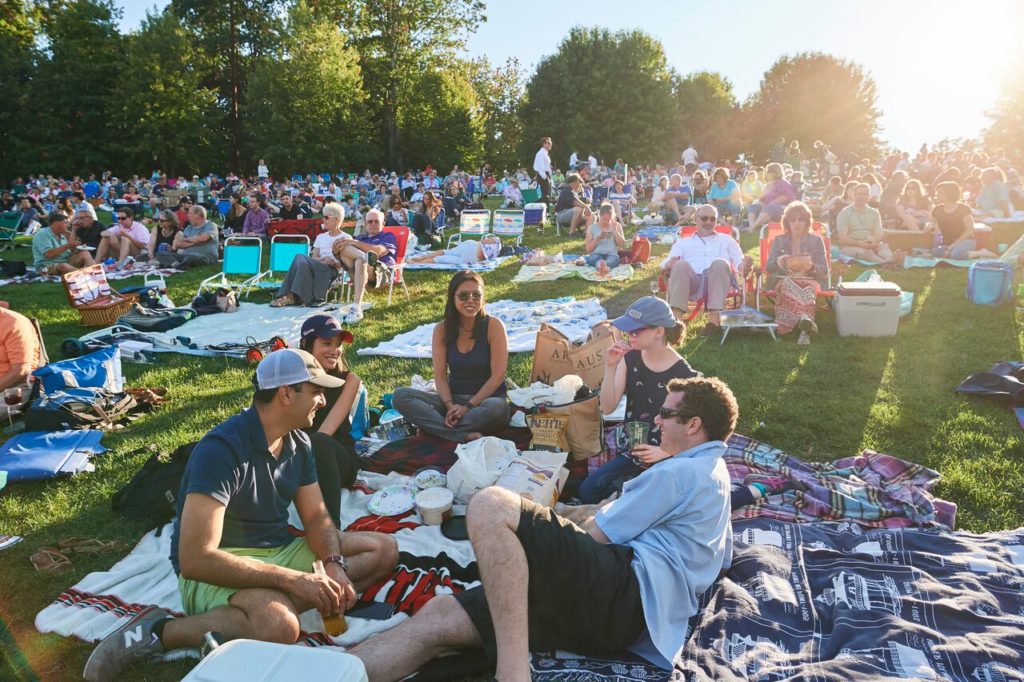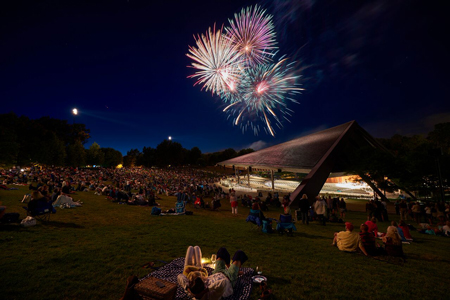by Neil McCalmont

On the evening of Saturday, July 9, thousands of listeners gathered in the pavilion, and on the lawn in the Blossom Bowl, spreading their blankets, reclining in their lawn chairs, and soaking up the warm summer night with their loved ones. The scent of wine and cheese wafted through the air at least an hour before the 8 o’clock concert even began. At summer festivals like this one, the atmosphere is at least as important as the entertainment.
The opening piece, “Overture, Waltz, and Finale” from Thomas Adés’s early chamber opera Powder Her Face, proved to be an excellent choice in programming, capturing the carefree mood of the evening. The opera revolves around the tumultuous liaisons of the Duchess of Argyll — the “Dirty Duchess” — in the 1960’s, and the music, here rescored by the composer for large orchestra, is equally as scandalous. Drunken slides in the violins permeate the Overture, executed brilliantly by the strings. The winds in the woozy Waltz flick notes that sound like the musical equivalent of seeing spots after one too many drinks. The accent of the beat becomes harder to discern as the dance continues, the “mistakes” carefully notated in Adés’s score. The tango-like Finale ends with musical flatuosité in the bassoons.
Béla Bartók wrote his masterpiece, Music for Strings, Percussion, and Celesta, at the height of his powers. It shows off his orchestration skill, knowledge of previous musical styles, and daring artistic novelty.
The strings played the Bach-like opening fugue with a soft, mesmerizing timbre that was eerily calming. By the time the theme had reached the violins and basses in the extreme ends of their registers, it made your skin crawl. Unfortunately, some of the ambiance was lost when a nearby train whistle interrupted for several minutes — in the same key as the piece, inspiring a murmur of laughter in the pavilion.
The scherzo-like second movement is full of fleeting pizzicatos, gracefully captured by the strings, who played them with a devious character. It also showcased the “Bartók pizz,” when the strings are plucked so hard they snap against the wood of the instrument. The following “night music” created a dissonant array of noise in the strings under hauntingly performed loops of sound in the harp and celesta, highlighting the composer’s excellent timbre choices. The finale featured Bartók’s trademark use of folk dances and wild rhythmic changes. While the performance was excellent, the piece’s particular instrumentation and the performance’s dynamic range didn’t work in such an open space. The audience’s reception seemed lukewarm.
Beethoven’s breakthrough work, the Symphony No. 3 “Eroica,” capped off the concert. This was the first of his symphonies to revolutionize the music world, famously dedicated to Napoleon until Beethoven heard he declared himself emperor, and scratched a hole through the dedicatee’s name. The monumental symphony also lasts nearly an hour, too long for audiences in the composer’s day.
Those audiences might have appreciated this performance, as music director Franz Welser-Möst set quick tempos for the symphony — often at the expense of the drama. The opening Allegro and Finale both seemed breathless; however, the orchestra performed brilliantly, impressively never missing a note or blurring a detail.
Noteworthy moments included Frank Rosenwein’s oboe line — dark, lamenting, and intensely satisfying — at the beginning of the “Funeral March.” The infamous “Blossom Boom” made a cameo appearance at the beginning of the third movement scherzo, but didn’t detract from the rousing trio section. The horn section here was unbeatable — playing the first dotted rhythm with the nobility of a lion, producing a rich, roaring sound whose bounce resounded throughout Blossom. Hats off to the horn players, who crowned off the evening.
After the lovely encore of Dvořák’s Waltz No. 1, Op. 54, a fireworks show provided a thrilling finish to the concert.
Photos by Roger Mastroianni, courtesy of The Cleveland Orchestra.
Published on ClevelandClassical.com July 11, 2016.
Click here for a printable copy of this article




